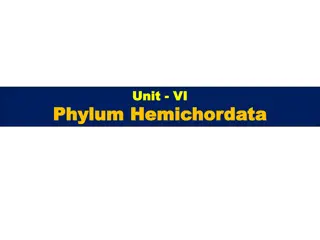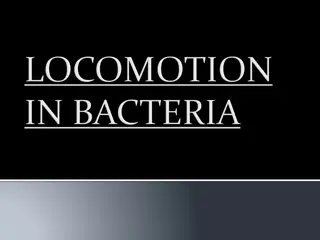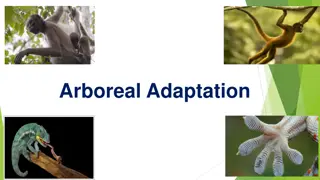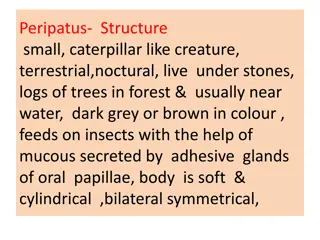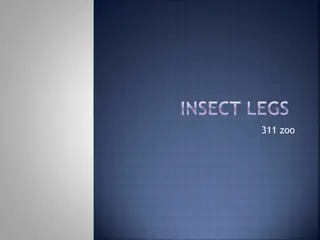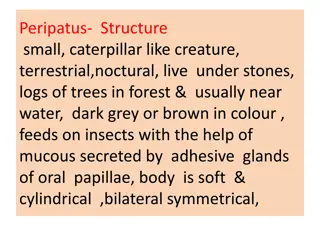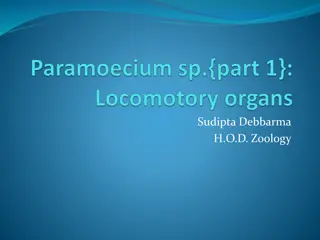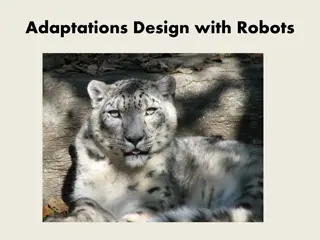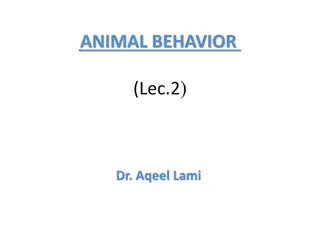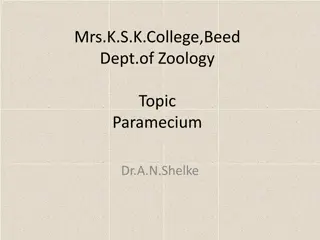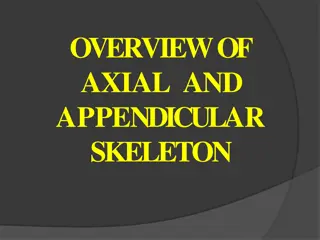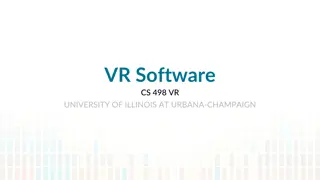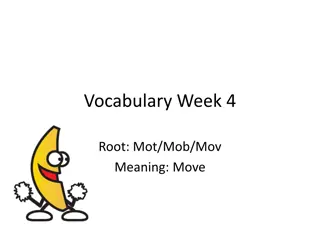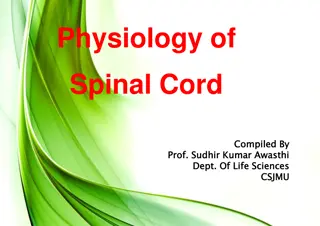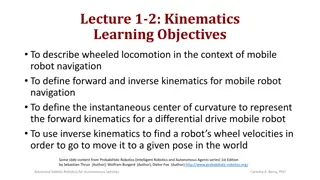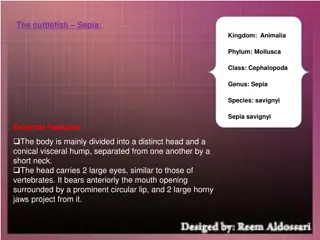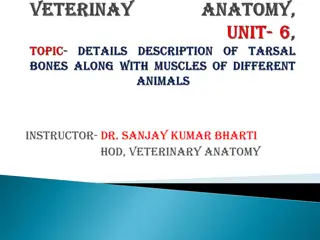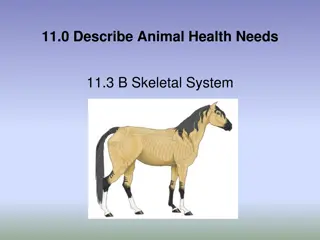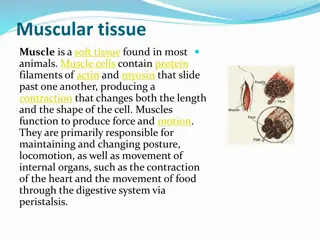Insect Abdominal Structures and Appendages: An Overview
The abdomen of insects plays crucial roles in respiration, reproduction, digestion, excretion, and metabolism. The number of abdominal segments varies across species, with reductions and modifications seen in different insect groups. From the propodeum to pregential and postgenital segments, each pa
1 views • 6 slides
The muscular system
The muscular system is a vital organ system that includes smooth, skeletal, and cardiac muscles. It plays a crucial role in locomotion, supporting the cardiovascular system, enabling lung ventilation, regulating fluids, maintaining posture, and generating heat in the body. This system consists of ar
2 views • 16 slides
External Morphology and Functions of Balanoglossus
Balanoglossus is an elongated, wormlike animal with a unique body structure divided into proboscis, collar, and trunk regions. The body wall consists of an outer epidermis, inner musculature, and peritoneum, providing protection and support. The proboscis is a club-shaped structure, the collar conta
0 views • 7 slides
Understanding Bacterial Locomotion: Flagellar Structure and Movement Mechanism
Bacterial locomotion involves intricate flagellar structures composed of filaments, basal bodies, and hooks. The synthesis of flagella is a complex process controlled by numerous genes. The rotation of the flagellar helix acts as a motor, determining the direction of bacterial movement.
1 views • 12 slides
Understanding Arboreal Adaptation in Animals
Arboreal locomotion refers to the movement through trees exhibited by animals like squirrels, sloths, and monkeys. These animals possess physical adaptations such as long limbs, prehensile tails, and claws to aid in tree climbing. Arboreal life offers safety, retreat, and easy access to food, shapin
0 views • 14 slides
Detailed Overview of Peripatus Structure and Anatomy
Peripatus, a small terrestrial nocturnal creature resembling a caterpillar, lives under stones and logs near water. Its body is cylindrical with indistinct segmentation and superficial ring-like annuli. The head features antennae, mandibles, and oral papillae, while the trunk bears walking legs with
2 views • 27 slides
Understanding Insect Legs: Anatomy and Adaptations
Explore the intricate anatomy of insect legs, comprising segments like coxa, trochanter, femur, tibia, and tarsus, each serving specific functions for locomotion. Discover how these legs are adapted for diverse tasks like walking and running in different insect species.
0 views • 18 slides
Anatomy and Characteristics of Peripatus
Peripatus is a small, caterpillar-like terrestrial creature found in forests near water. It has dark grey or brown color, feeds on insects using mucous secreted by adhesive glands, and has a soft cylindrical body with bilateral symmetry. The body is divided into a head and trunk, with distinct featu
1 views • 27 slides
Understanding Paramoecium Caudatum: A Microscopic Organism with Unique Characteristics
Paramoecium caudatum is a typical ciliate protozoan characterized by the presence of cilia as a locomotor organelle, nuclear dimorphism, and a unique form of sexual reproduction called conjugation. Commonly found in freshwater habitats, this microscopic organism has a distinct structure with a pelli
3 views • 10 slides
Vertebrates Final Review - Study Guide with Images
Explore the world of vertebrates with this comprehensive final review. Learn about chordates, fish, amphibians, reptiles, birds, and mammals through informative images and questions. Test your knowledge on topics like excretion, respiratory organs, locomotion, and anatomical features unique to chord
0 views • 74 slides
Understanding Protozoa: The Animal-Like Unicellular Organisms
Protozoa are unicellular heterotrophic organisms that obtain nutrition by ingesting other organisms or dead organic material. They can be parasitic and are classified based on their modes of locomotion. Common groups include amoebas, flagellates, sporozoans, and ciliates. Protozoa are further catego
0 views • 16 slides
Understanding Primate Characteristics: Movement, Dexterity, and More
Primate characteristics encompass a range of physical traits tailored for their environments, like adept movement abilities and dexterity in their hands and feet for grasping objects. Their unique skeletal structure allows for flexibility and skilled locomotion. Learn about the fascinating features
0 views • 11 slides
Understanding Animal Adaptations and Robotics in Design
Explore the world of animal adaptations and how they inspire robotic designs. Learn how animals utilize specialized body parts to survive in their habitats and how engineers apply these concepts in biomimicry to create innovative solutions. Delve into the importance of locomotion, measuring techniqu
0 views • 17 slides
Understanding Animal Behavior: Insights from Dr. Aqeel Lami's Lectures
Animal behavior, as explored through the lenses of ethology, behavioral ecology, and sociobiology, reveals fascinating insights into the activities, interactions, and evolutionary underpinnings of various species. From locomotion to foraging strategies to social behaviors, the field sheds light on t
0 views • 6 slides
Exploring Paramecium: A Detailed Study of a Protozoan Organism
Paramecium, a widely studied protozoan organism, is found in various freshwater habitats. It exhibits unique characteristics such as locomotion through cilia, holozoic nutrition, and intracellular digestion. This microscopic organism reproduces both asexually and sexually, displaying a complex nucle
0 views • 8 slides
Understanding the Axial and Appendicular Skeleton in Vertebrates
The axial skeleton consists of the bones in the head and trunk, while the appendicular skeleton supports the limbs in vertebrates. The appendicular skeleton aids in locomotion and manipulation, comprising 126 bones in total. Understanding the structure and functions of these skeletal systems is vita
0 views • 23 slides
Virtual Reality Software System at University of Illinois
The Virtual Reality Software System at University of Illinois leverages a Virtual World Generator to create alternative realities using synthetic models or real-world data. Tasks for the Virtual World Generator involve matched motion and user locomotion, while dealing with challenges like collision
0 views • 33 slides
Exploring the Root 'Mot/Mob/Mov' in Vocabulary
Delve into the meaning of movement with words like comprehend, promote, mobilize, and motivate. Understand the impact of demotion and the significance of motion, locomotion, and discrimination. Explore terms like automobile removal and the concept of locomotion. Familiarize yourself with actions suc
0 views • 13 slides
Understanding the Physiology of the Spinal Cord
The spinal cord serves as the information highway between the brain and body, allowing for sensory input reception and motor signal transmission. It plays a crucial role in locomotion, reflex responses, and overall coordination of muscle activities. The cylinder of nerve tissue within the vertebral
0 views • 18 slides
Understanding Mobile Robot Kinematics for Navigation
Exploring the kinematics of wheeled locomotion in mobile robots, this content covers forward and inverse kinematics, instantaneous center of curvature, and the use of kinematics for robot navigation. Highlighting the challenges of measuring robot position and the integration of wheel velocities for
0 views • 52 slides
The Amazing Cuttlefish and Starfish
The cuttlefish, Sepia savignyi, features distinct external characteristics such as a conical visceral hump, eyes, arms with suckers, and tentacles used for capturing prey. On the other hand, the starfish, Astropecten relitaris, showcases a star-shaped body with tube feet for locomotion, pedicellaria
0 views • 8 slides
Study on Physiological Functions Using Chronophotographic Gun
Étienne-Jules Marey's pioneering work in time-resolved photography for studying physiology inspires a proposal for a quantitative analysis of physiological functions using similar techniques. The project involves analyzing videos to study postures, locomotion, and other important physiological para
0 views • 7 slides
Veterinary Anatomy: Tarsal Bone Structure and Function
The veterinary anatomy lesson delves into the intricacies of the tarsal bone in oxen, detailing its composition, arrangement of short bones, and specific features like the tuber calcis and articulation points. The tarsus comprises different rows of bones, each serving a specific function in locomoti
0 views • 24 slides
Understanding Animal Skeletal System: Importance and Components
The skeletal system in animals plays a crucial role in providing structural support, facilitating movement, and offering protection to vital organs. It is composed of various components like bones, joints, ligaments, tendons, compact bone, and spongy bone. Different types of bones in an animal's bod
0 views • 13 slides
Understanding Muscle Tissue: Structure and Function
Muscle tissue is a vital component in most animals, facilitating movement and maintaining posture. Derived from embryonic cells, muscles come in three types: skeletal, cardiac, and smooth, each serving specific functions in the body. While skeletal muscles are under voluntary control, cardiac and sm
0 views • 15 slides
George Stephenson's Life and Timeline Compared
George Stephenson, a renowned engineer, made significant contributions such as creating the Locomotion in 1814 and The Rocket in 1829. He worked in a coal mine and played a crucial role in the development of railways. Comparing his life events to a personal timeline emphasizes the impact of his achi
0 views • 4 slides


